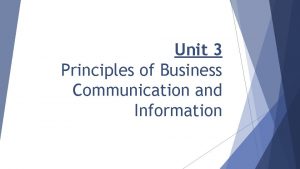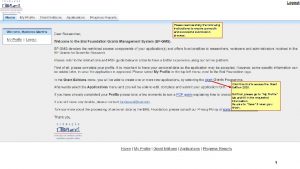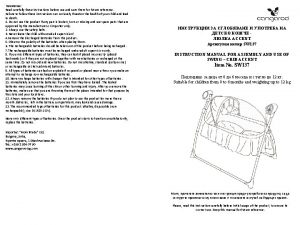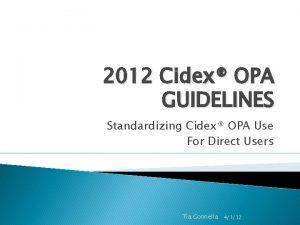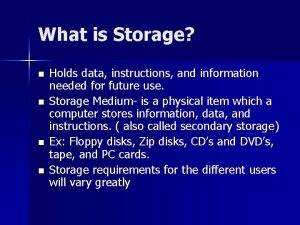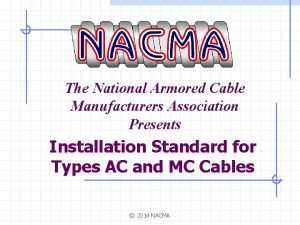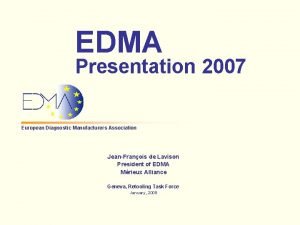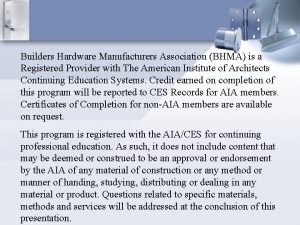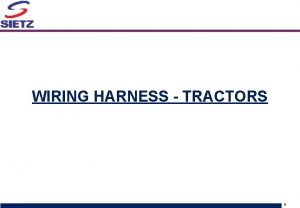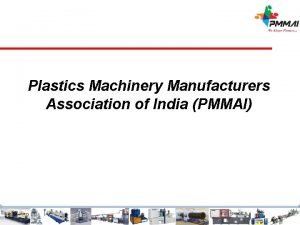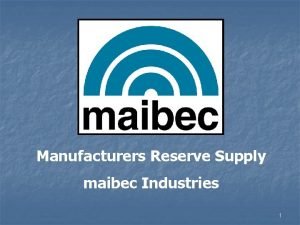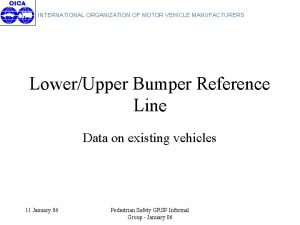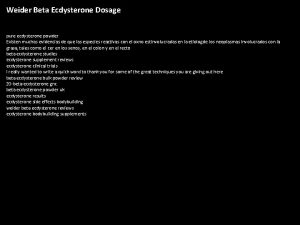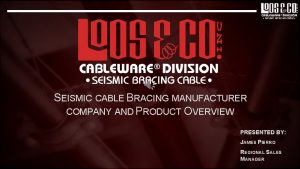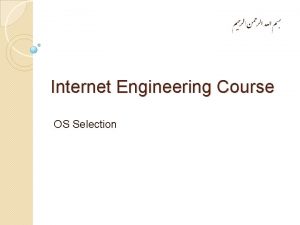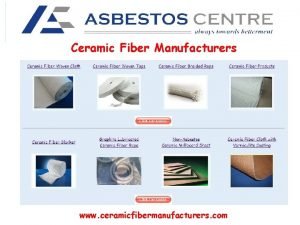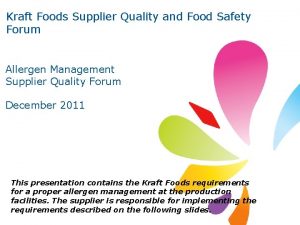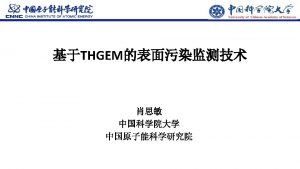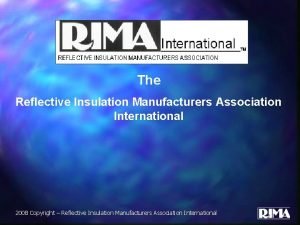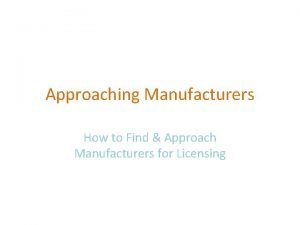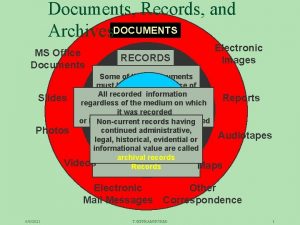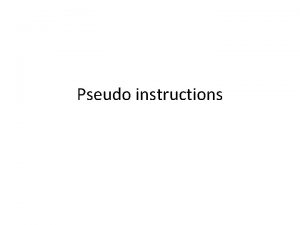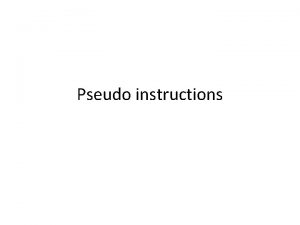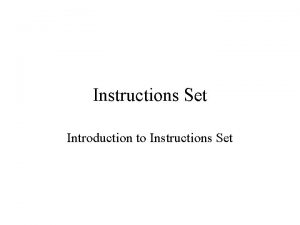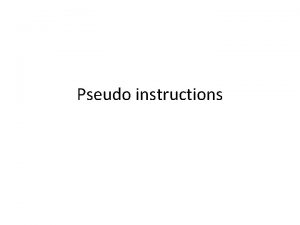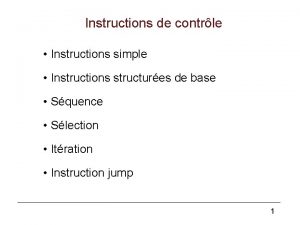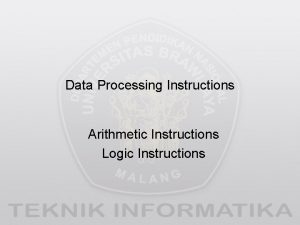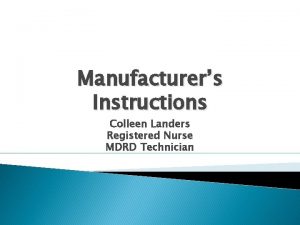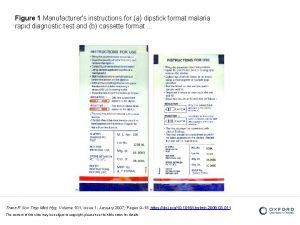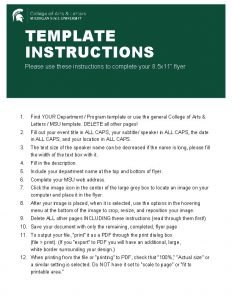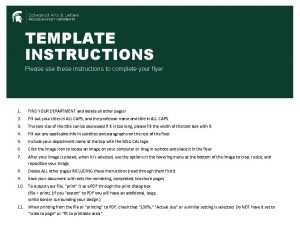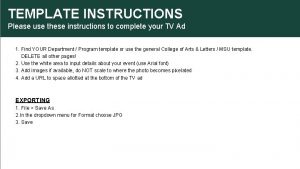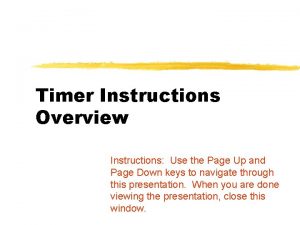The Importance of Manufacturers Instructions for Use Documents






































- Slides: 38

The Importance of Manufacturers’ Instructions for Use Documents Quality Assurance and Control For Healthcare Facilities

Connecticut Central Service Association President 2008 09 10 11 12 13 14? 15? 16? 17? AAMI STWG 40 (ST 79) voting member IAHCSMM Ortho council IAHCSMM Executive Board 2011 -12 2012 -2013 IAHCSMM President Elect 2013 -2015 David Jagrosse Consulting L. L. C. President 203 -465 -8502 Manager Middlesex Hospital Central Sterile Service 28 Crescent Street Middletown, CT 06457 860 -344 -6269 “One of Youz Guyz”

Why are Manufacturers’ Instructions (IFU) Important? • IFU provide instructions the device manufacturer states are needed to properly process their device • Patient safety in surgery requires properly processed instruments – Improperly processed instruments have been linked to patient injury* – Not following IFU puts patients at risk 1. Us Dept of Veterans Affairs http: //1. va. gov/opa/pressrelease. cfm? id=1661 Cutler Peck, et al. Journal of Cataract and Refractive Surgery 2010 Jul; 36(7): 1073 -80. 2. Today Show. Dirty surgical instruments. . . 3. http: //today. msnbc. com/? id=29383169&q=dirty+surgical+instruments&p=1&st=1&sm=user&search=

Why are the Manufacturers’ Instructions (IFU) Important? • In accordance with FDA and AAMI Guidelines the device manufacturer has validated the steps necessary to prepare a device that is safe for patient use, for example: – Cleaning, testing for function, packaging, and sterilization – Healthcare facilities are not equipped to validate – Users must depend upon manufacturer for validated IFU www. Onesource. docs. com

Why should you follow the IFU? • “Use of medical devices in accordance with manufacturers’ instructions” is recommended by: – The Association for Advancement of Medical Instrumentation (AAMI)* – The Association of peri. Operative Registered Nurses (AORN) – The Centers for Disease Control and Prevention (CDC) – Following manufacturers’ IFU is necessary to deliver a safe product for surgery AAMI ST 79: 2012. Sec. 7. 2. 2 AORN 2012 Standards and Recommended Practices – Care and Cleaning of Surgical Instruments CDC 2008 –Guideline for Disinfection and Sterilization in Healthcare Facilities www. Onesource. docs. com

Joint Commission and Centers for Medicare and Medicaid Requirements • The Joint Commission now requires that during an audit Sterile Processing Departments show current manufacturers’ instruction for use documents and how they are used • The Centers for Medicare and Medicaid Services (CMS) also requires the presence of manufacturers’ IFUs for audits on the Infection Control Surveyor Worksheet www. Onesource. docs. com

The Joint Commission • National Patient Safety Goals NPSG. 07. 05. 021 • As of Jan 2010, the hospital implements policies and practices aimed at reducing the risk of surgical site infections that meet regulatory requirements, are aligned with evidence-based standards. . . and/or professional organization guidelines Joint Commission Manual on Hospital Accreditation National Patient Safety Goal, Element of performance E 3 http: //www. jointcommission. org/assets/1/6/NPSG_Chapter_Jan 2012_CAH. pdf www. Onesource. docs. com

How Does the Joint Commission Ensure Your Compliance? www. Onesource. docs. com

The JC will observe instruments from when they leave one OR to when they are returned to the next Transport to OR room Use in surgery wipe, moisten, irrigate during procedure Transport to decontamination Put in storage Transport to OR Disassemble Sterilize Soak • if delay • if tenacious debris Load sterilizer Assemble and package Inspect for cleanliness test for function Clean manual and/or automatic www. Onesource. docs. com

The Joint Commission May: • Ask healthcare workers to provide the device, the packaging and the sterilizer IFU • Ask healthcare workers to demonstrate cleaning and decontamination • Observe that cleaning and decontamination matches the IFU • Observe that sterilization matches the IFU • Ask about the chemical and biological indicators www. Onesource. docs. com

How Does CMS Ensure your Compliance? www. Onesource. docs. com

CMS – Infection Control Survey Worksheet – Observations are to be made of staff who perform equipment reprocessing (e. g. , surgical techs), unless these activities are performed under contract or arrangement off-site from the ASC – Items pre-cleaned according to IFU – High-level equipment maintained according to IFU – Chemicals prepared, tested, replaced, documented according to IFU – Instruments disinfected as specified in manufacturers’ IFU

CMS • “If manufacturers’ instructions are not followed, then the outcome of the sterilizer cycle is guesswork, and the ASC’s practices should be cited as a violation of 42 CFR 416. 44(b)(5). ” (CMS, 2009) • Ref S&C-09 -55 (Revised 10 -09 -2009 http: //www. cms. gov/Survey. Certification. Gen. Info/downloads/SCLetter 09_55. pdf www. Onesource. docs. com

How Does Inadequate IFU Document Compliance Affect Patient Safety !!! If facilities don’t follow Manufacturers’ IFUs, patient safety is threatened because medical devices may be • Cleaned improperly • Wrapped improperly • Loaded into sterilizer improperly • Sterilized using the incorrect type of sterilization process or cycle parameters for the device or load • Disassembled and assembled improperly www. Onesource. docs. com

How Can Following Proper IFU Documents Minimize Operator Errors? • Not following IFU is a major contributor to sterilization process failures • Being trained to follow up-to-date IFUs can reduce operator errors • Staff responsible for instrument processing are responsible for having on hand current IFU that are available to staff at all times. www. Onesource. docs. com

How Can You Obtain Current IFU Documents? • IFU are provided with the new medical device upon purchase and can also be received by calling the manufacturer of the medical device. • You can build your own library of documents or • You can outsource one. SOURCE - a library of documents www. Onesource. docs. com

What Are The Requirements of Your Library of IFU Documents? • The documents must be up to date and readily available to the operators. • The documents must cover all of your instrumentation. • The documents should be easy-to-use and communicate to others within the hospital. • The documents should be in a credible condition to auditors and surveyors to be easily reviewed with them. www. Onesource. docs. com

Have you ever experienced. . . • Do not have Manufacturers’ Instructions for Use (IFU): • Think you have IFU but cannot locate • Not sure you have the most current IFU • § Have difficulty obtaining an IFU § Not sure who to contact at medical device company Time constraints that make it difficult to track down IFU and keep them current. . . www. Onesource. docs. com

Middlesex Hospital • Long journey of starting A-Z search obtaining library of IFU’s. • Paint analogy-Start in one area and by the time we were done we had to make sure they were updated. 1 year process. 1 FTE • Scanned to computer but then we still had to update and categorize. • Available in all locations-went to online database

IFU Library? Accessible?

So what does the future hold? • FDA Draft Guidance Document issued May, 2011: – Processing/Reprocessing Medical Devices in Health Care Settings: Validation Methods and Labeling Draft Guidance for Industry and FDA Staff issued on May 2, 2011 Processing/Reprocessing Medical Devices in Health Care Settings: Validation Methods and Labeling

FDA Draft Guidance on Reprocessing • FDA recommends: – Sterilization parameters be technically feasible for end-users • i. e. recommended sterilization parameters should be consistent with cycle parameters found on sterilizers commonly available in health care facilities – Device manufacturers generate validation data in FDA-cleared sterilizers and with FDA-cleared accessories. Draft Guidance for Industry and FDA Staff issued on May 2, 2011 Processing/Reprocessing Medical Devices in Health Care Settings: Validation Methods and Labeling

FDA Draft Guidance on Reprocessing • The FDA recognizes the challenge extended cycles pose to health care facilities • “FDA advises against including extended cycle recommendations in product labeling for a number of reasons. ” Draft Guidance for Industry and FDA Staff issued on: May 2, 2011 Processing/Reprocessing Medical Devices in Health Care Settings: Validation Methods and Labeling

FDA Draft Guidance on Reprocessing Appendix provides examples of cycles used in health care facilities • Draft Guidance for Industry and FDA Staff issued on May 2, 2011 Processing/Reprocessing Medical Devices in Health Care Settings: Validation Methods and Labeling

What is the following I. F. U. From?

As with any decontamination procedure, personnel should follow accepted guidelines for hand washing, the use of protective attire, etc. as recommended by A. A. M. I. Standards and Recommended Practice, “Safe Handling and Biological Decontamination of Medical Devices in Health Care Facilities and in Non-Clinical Settings”, ANSI/AAMI ST 35: 2003. Decontamination is a two step process: 1) Thorough cleaning and rinsing. 2) Sterilization or disinfection.

A. MANUAL DECONTAMINATION PRECLEANING: Remove gross debris from surgical instruments with a lap sponge and sterile water routinely during the procedure to prevent drying on of blood and body fluids, etc. It is important to rinse instruments that have been exposed to blood and saline solution before these substances dry. Blood and body fluids as well as saline solutions are highly corrosive. In addition, blood can produce a stain that is difficult to remove CLEANING: To prevent the formation of biofilm, cleaning should occur as soon as possible after instrumentation is used. Biofilm is an accumulation of a biomass of bacteria and extracellular material that tightly adheres itself to the surface of the instruments. It cannot be easily removed, and protects microorganisms from being easily removed by ordinary cleaning/decontamination methods used in hospitals. It is particularly problematic in lumened medical devices. Step 1. Maintain moisture: Immediately after the surgical procedure, place the instruments in an instrument tray/container and cover with a towel moistened with sterile distilled water. Foam, spray or gel products, specifically intended for use with surgical instruments, are available to keep the soil moist. Transport tray of soiled instruments in an impervious plastic bag or container with a tight lid to the decontamination environment (keep the outside of the containment clean) Step 2. Enzymatic Soak: Immerse fully opened and/or disassembled instruments in an enzymatic solution, specific for use with surgical instruments. Prepare the solution and use per enzyme manufacturer’s recommendations, paying special attention to instructions for correct dilution, temperature and soak time. Flush air from lumens and fill them with enzymatic solution for full contact with this inner surface during the soak time.

Step 3. Rinse: Remove from enzymatic soak after the time period recommended by the enzymatic manufacturer and rinse thoroughly with tap water. Flush lumens until rinse water runs clear. Step 4. Cleaning Instruments: Choose a cleaning solution appropriate for surgical instruments and follow the manufacturer’s instructions for use. The use of neutral p. H detergents is vital to the maintenance of surgical instruments. Contact with acidic or alkaline solution will remove the instruments’ protective barrier of chromium oxide, often leading to corrosion, pitting, and breakage. You may find that depending on the type of soil, a detergent that is a little more or less acid or alkaline may be more appropriate. The ideal cleaning agent is nonabrasive, low-foaming and freerinsing. Using a small clean hand-held brush, remove soil from all surfaces of the instrument while fully immersed in the solution. During manual cleaning, never use steel wool, wire brushes, scalpel blades or highly abrasive detergent or cleansers to remove soil from surgical instruments. These will damage the instruments’ protective surface and lead to corrosion. Use a clean soft bristled brush to clean instruments with an accessible channel. Remove the soil from the ratchets, jaws, tips, box locks, and/or hinge mechanism. Step 5. Rinse: Thoroughly rinse instruments by immersing in tap water and wiping with a clean, soft cloth. Flush lumens until water runs clear Step 6. Ultrasonic Cleaning and Rinsing: Follow the recommendations of the ultrasonic manufacturer regarding cycle times, detergents, proper placement of the instrument tray, and conditioning (“degassing”) of the cleaning solution, etc. Use an ultrasonic cleaner to remove soil from hard to reach surfaces such as grooves, crevices, lumens, instruments with moving parts, etc. , after gross soil has been removed. Open or disassemble instruments as appropriate. Place instruments in a mesh bottom stainless steel instrument tray. Place the tray into the ultrasonic cleaner. Flush air out of lumens and fill them with the ultrasonic cleaning solution (under the solution level in the chamber) for effective removal of soil from that inner surface by the ultrasonic activity.

Step 7. FINAL RINSE should be with “treated water”. Softened or deionized water should be used for the final rinse to better remove detergents etc. Softening water removes calcium and magnesium ions that cause water to be hard. Iron ions may also be removed by this treatment. Deionization removes ionized salts and particles from the water. Excessively hard water can spot or stain instruments and excessive chlorine in water can cause pitting of the instrument. Deionized water is preferred for the final rinse Step 8. Decontaminate Clean Instruments: Once instruments have been cleaned they must be rendered safe for handling, inspection and assembly. They may be steam sterilized without a wrapper or disinfected following the instructions from the instrument, sterilizer and disinfectant manufacturers. Step 9. Visual Inspection and Instrument Set Assembly: Visuallyinspect the instrument for cleanliness and to ensure all parts are in proper working order, as the set is assembled. Inspection is a vital part of proper care and maintenance. Instruments in need of repair will not perform accurately in surgery and breakage is likely to occur. DO NOT USE damaged instruments. Worn ratchets, loose box locks and misaligned jaws can be repaired at a fraction of the cost of new instruments. Contact your local representative for information regarding a cost-effective instrument repair program.

Step 10. Lubricate: The use of an instrument lubricant, that is compatible with the method of sterilization to be used, is recommended before instruments are sterilized. Be certain that the instrument lubricant is diluted and maintained properly, according to the manufacturer’s instructions. This type of lubricant is referred to as “instrument milk” and is usually applied by spraying into the box locks and moving parts or by dipping the opened instruments into a solution. Lubricants that are too concentrated or too heavily applied will result in slippery instruments that will also be mistaken as wet after sterilization. After thoroughly cleaning instruments, proper application of lubricants to joints will keep them moving freely and aid in protecting the surface from mineral deposits. Note that ultrasonic cleaners remove all lubrication; therefore this maintenance procedure should be done routinely after ultrasonic cleaning and before sterilization. Proper lubrication is an integral step in maintaining the long-life of the surgical instrument. Lubrication will prevent the friction of metal on metal and preserve the smooth function of the instrument thus avoiding corrosion by friction. Furthermore, routine use of lubricating agents, on thoroughly clean instruments, will prevent hinged and other movable parts from sticking. Lubrication will aid in protecting the entire instrument surface from mineral deposits. Step 11. Drying: Before instruments are wrapped for sterilization or storage, they must be thoroughly dry. If a set of instruments is wet when wrapped for sterilization it is likely to come out of the sterilizer wet. “Wet Packs” are not suitable for use after sterilization because they may be easily contaminated when handled. In addition, remaining moisture, particularly in box locks and hinges may result in corrosion that will weaken the instrument and lead to breakage during use. Prepare instrument sets for sterilization using a wrapper, pouch or rigid sterilization container that is appropriate for the method of sterilization to be used. The Association for the Advancement of Medical Instrumentation (AAMI) and individual sterilizer manufacturers provide guidance for the proper preparation of surgical instrument trays for sterilization. Some sterilizer manufacturers can also provide information regarding wet pack problem solving. See also, Sterilization for the Healthcare Facility, 2 nd Edition, Reichert, M. ; Young, J. , “Wet Pack Problem Solving”, Lee, S. (Frederick, MD: Aspen, 1997).

B. MECHANICAL DECONTAMINATION General surgical instrumentation may be processed in a washer sterilizer or washer decontaminator/disinfector. Some of these processes include an enzyme application phase and a lubrication phase that is designed into the cycle. Follow the manufacturer’s specifications when using automatic washer-sterilizers or washer decontaminators/disinfectors. They usually require the use of a low foaming, free rinsing detergent with a neutral p. H (7. 0). A high-foaming detergent may clean effectively but will often leave residual deposits on the instruments and do harm to mechanical washers. Automated washer sterilizers and washer decontaminator/ disinfectors usually have adjustable wash and rinse times. Some washers enable the user to customize extra cycles to process heavily soiled surgical instruments more effectively. Check with a Technical Service representative at 1 -800 -431 -1123 for questions regarding processing delicate, complex and/or multipart instruments by this method. C. TERMINAL STERILIZATION After following the decontamination recommendations, reusable instruments are ready for sterilization. Independent laboratory testing, conducted according to the F. D. A. (21 CFR PART 58) and Good Laboratory Practice Regulations (G. L. P. ), has validated steam sterilization as an effective process for reusable instruments. See also, AAMI Standards and Recommended Practices, “Steam Sterilization and Sterility Assurance in Health Care Facilities”, ANSI/AAMI ST 46: 2002; “Flash Sterilization Steam Sterilization of Patient Care Items for Immediate Use, ANSI/AAMI ST 37: 3 ed. AAMI standards recommend that the sterilizer manufacturer’s written instructions for cycle parameters should also be followed. Steam sterilization of lumened instruments requires that they be flushed with sterile water just prior to wrapping and sterilization. The water generates steam within the lumen to move air out. Air is the greatest enemy to steam sterilization, preventing steam contact if not eliminated. Medical device manufacturer’s exposure times to sterilization temperature may need to be longer than the minimum indicated by the sterilizer manufacturer but must never be shorter.

MAINTENANCE PROCEDURES Improper, ineffective, and insufficient maintenance can greatly reduce the life of an instrument and will invalidate the instrument’s warranty. We cannot make any statement about how long an instrument will last. Designed and crafted to exacting specifications, instruments will perform for a reasonable number of years when the following steps are observed: Protect Instruments: The most effective method of dealing with instrument problems is to prevent them from occurring. The use of “treated water”, careful preliminary cleaning, the use of neutralized p. H solutions, adherence to manufacturer’s instructions, and visual inspection, will help to keep instruments performing accurately and cosmetically free of troublesome stains. It is important to act quickly should a problem arise. Delay will compound the problem and irreparable harm may result. Certain compounds are highly corrosive to stainless steel and will cause serious damage despite the passivated protective surface. If instruments are inadvertently exposed to any of the following substances, they should be rinsed immediately with copious amounts of water. Instruments should never be exposed to: Aqua regia Iodine, Ferric chloride, Sulfuric acid, Hydrochloric acid The following substances should be avoided whenever possible: Aluminum chloride Mercury chloride, Barium chloride Potassium permanganate, Bichloride of mercury Potassium thiocyanate, Calcium chloride, Saline, Carbolic acid Sodium hypochlorite, Chlorinated lime Stannous chloride, Dakin’s solution • Any kind of corrosion will lead to rust on steel. Because rust particles can be transferred from one instrument to another, corroding instruments should be removed from service to prevent the formation of rust on other instruments. • Instruments must be sterilized in the open position or disassembled as appropriate. Steam will only sterilize the surface it can directly touch. • Every effort should be made to protect sharp cutting edges and fine working tips during all maintenance procedures. Avoid loading retractors and other heavy items on top of delicate and hollow instruments.

It is for common surgical instruments!!!

Are you doing all you can? ? ?

Fight for professionalism • Fight for self through education • Fight for co-workers through participation • Fight for the best patient care through certification and recognition for our profession

IAHCSMM State by state battle for recognition for our profession. Certification key We must fight for what we deserve! No one is going to hand it to you. Through unity and strength we can do it!

Support your society! Join the struggle!!! • "Those who expect to reap the blessings of freedom must, like men, undergo the fatigue of supporting it. " Thomas Paine

Change will not come about through expectation –Dave Jagrosse
 Explain the use of bespoke business documents
Explain the use of bespoke business documents What holds data instructions and information for future use
What holds data instructions and information for future use Please read the instructions carefully
Please read the instructions carefully Use to give orders or instructions
Use to give orders or instructions Please read instructions carefully before use
Please read instructions carefully before use Cidex opa log sheet
Cidex opa log sheet Nnnqq
Nnnqq Please read instructions carefully before use
Please read instructions carefully before use Hin format
Hin format Mc cable supplier
Mc cable supplier Best autogyro
Best autogyro European diagnostic manufacturers association
European diagnostic manufacturers association Builders hardware manufacturers association
Builders hardware manufacturers association Sai paradise machine tools
Sai paradise machine tools Manufacturers seeking distributors
Manufacturers seeking distributors Surshot
Surshot Pmmai
Pmmai Indian pharma association
Indian pharma association Maibec shingle colors
Maibec shingle colors Car bumper height
Car bumper height Beta ecdysterone bulk powder
Beta ecdysterone bulk powder Wholesale p cable seismic
Wholesale p cable seismic Server manufacturers
Server manufacturers Ceramic fiber manufacturer
Ceramic fiber manufacturer Center pivot irrigation layout
Center pivot irrigation layout Elisa kraft
Elisa kraft Husky plastic injection molding factories
Husky plastic injection molding factories Booster auto manufacturers
Booster auto manufacturers Ambio pharm
Ambio pharm Cathode mesh manufacturers
Cathode mesh manufacturers Reflective insulation manufacturers association
Reflective insulation manufacturers association Investment casting wax exporter
Investment casting wax exporter Ifpma code
Ifpma code Kontinuitetshantering
Kontinuitetshantering Novell typiska drag
Novell typiska drag Tack för att ni lyssnade bild
Tack för att ni lyssnade bild Vad står k.r.å.k.a.n för
Vad står k.r.å.k.a.n för Varför kallas perioden 1918-1939 för mellankrigstiden
Varför kallas perioden 1918-1939 för mellankrigstiden En lathund för arbete med kontinuitetshantering
En lathund för arbete med kontinuitetshantering
